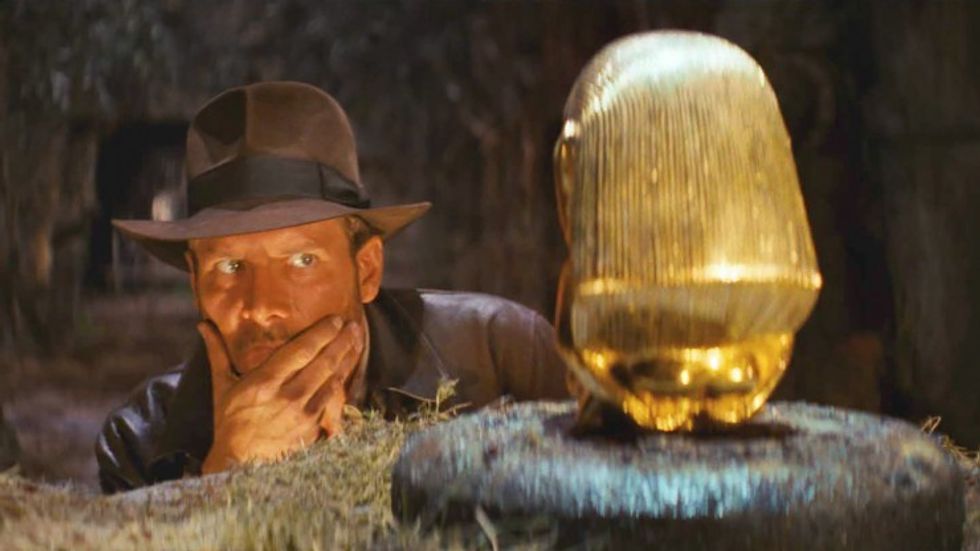12 Steps for Pitching Your Story Right Down the Middle
Without a great pitch, no one will know how great your story is. Here are some tips from Passion River's Head of Acquisitions Mat Levy on how to pitch like a pro.

Having a great idea in your head is one thing, communicating it properly is another…and persuading someone that it’s a viable concept is the real challenge. Chances are, you’ve already fumbled a pitch or two—whether to an actual production exec or to a confidante over coffee. It’s hard to sell people on an idea without a fundamental plan.
That’s where Mat Levy comes in. Since 1998, Passion River has released over 98 films, including this year’s Best Documentary Emmy-winner, I Am Evidence. Levy receives close to 500 pitches per year as Head of Acquisitions, and every time he takes on content, he has to switch hats and pitch his choices to the top streaming platforms. So when it comes to selling ideas, it’s safe to say he knows what he’s talking about.
In fact, earlier this year, IFP hosted a stellar workshop in Brooklyn led by Levy, whose topic was pitching: a twelve-step crash course on how to power up your pitch and hit a home run.
Maybe you’ve read one of my earlier pieces on pitching—and you know the general guidelines. What separates those how-to’s from Levy’s advice is hands-on practice: in his workshop, participants were asked to absorb his twelve steps, then pitch their own projects to fellow classmates, myself included. Basically, I swallowed my fear, changed my usual presentation to suit Levy's guidelines, and wound up delivering the best pitch I've done to date.
Here’s exactly what I did to improve my delivery: it’s all about asking (and answering) some very specific questions.

STEP #1. Who Are You?
It may seem basic to hit yourself with the “who/what/where/when/why’s” right up front, but without addressing these questions, your pitch may wind up with a few gaping holes.
Who are you?
How will your audience perceive you? What may work in your favor, or not, and what should you be aware of?
What are you pitching?
Is it a limited series, a short film, a novel? What’s the format, the timeline, the specs?
Why are you pitching it?
Why do you need to share your idea with someone else? Are you just looking for permission to hear yourself talk or is there a tangible goal?
What do you want out of the pitch meeting?
Know your goal before you begin. What is your best-case scenario? What specific result are you going to request from your audience?
What makes you the *best* person to pitch this concept?
This one is easy to forget, and so important. Make your pitch inevitable. Show your audience that you are exactly the right person for your idea.
Why does your story matter?
If you’re just one of the year’s 500 pitches, why should you get special treatment? Who’s to say your idea isn’t just a blip on the timeline? What makes it a game-changer?
As you can surmise from the above, self-awareness is key. You may think all these questions are simplistic, but what may seem obvious to you before you start pitching is easy to forget when you’re presenting to a first-time listener. According to Levy, most of the pitches he hears leave out crucial details…so listen up!
I know I had to. I’ve definitely made this mistake: I’d spend so much time worrying about the strength of the idea, that I would overlook my own presence in the room. So even if it makes you uncomfortable, practice! Just for a few minutes, pretend you’re a stand-up comedian or a Keynote speaker and emphasize why you.

STEP #2. Who is the Client?
Why should anyone else care?
Think beyond your own personal stake. Why should someone else decide to become invested in your idea?
What’s in it for them?
Don’t just claim that your topic will matter to others. Provide tangible proof that your project has an audience, a market, beyond this meeting.
“You have to know your client better than you know yourself,” Levy insisted. "They’re the ones risking their careers for your idea. You can’t just expect these guys to give you money because they have it. You have to think two steps beyond. What are they looking for? Are they actually looking for my product or service?”
Take Netflix, for example. The company produced over 300 original series in 2017. Original programming is vital to the company’s continued success; over 60 percent of subscribers state that original shows are absolutely essential when it comes to their decision to use Netflix. Yet, in order to attain these numbers, innumerable pitches are delivered to the streaming platform every day. Know that the odds are stacked against you, and know exactly what your client needs. Because if you don’t have an airtight plan for how your work would fit into their oeuvre, you can bet that at least 300 other people do.

STEP #3. How Do You Keep their Attention?
Snapping the audience awake mid-lecture, Levy emphasized that nowadays, attention spans are dead. “Everyone has ADD these days,” Levy laughed. “When you pitch, always aim for five minutes if possible. This helps the client know that it’s gonna take about that much time for them to pitch the idea to their partners. Ten minutes should really be the absolute limit, and that’s pushing it.”
Look at pitching like writing a first draft: you may be tempted to overcomplicate with flowery prose…but the final edit needs clarity. "Investors hate wasting time on bad ideas. Your client’s time is very valuable,” Levy explained. “Don’t make them snooze or you’ll lose the deal.”
Short and sweet is your goal.

STEP #4. Have You Boiled Your Idea Down to its Absolute Essence?
Perhaps you’re afraid your pitch won’t stand out if you don’t fill in enough details—that your client won’t see its originality. Consider your favorite movies and TV shows of all time: chances are, they’re all a hell of a lot simpler to describe than you’d expect.
Try recommending your favorite movie to a friend. Can you describe it in a sentence or two? Say it’s Raiders of the Lost Ark. Would you say, “In 1936, a swashbuckling archaeologist races against the Nazis to find the fabled Ark of the Covenant?” Or would you say, “It’s an action-adventure movie about a badass history teacher who fights Nazis?” Or, “James Bond, but he whips guys and hunts treasure.” There’s no one right answer, but if you stay laser-focused, you’ll find the one that best suits you … and your story.
Once you figure out how to deliver your story in a bite-sized chunk, this practical packaging will carry over into the next round of pitching.

STEP #5. When Should You Hook Your Audience?
Again, don’t dawdle. Whether it’s the client you’re pitching to or the people who will eventually see your film, you need to engage your audience and keep them hooked. Chances are, there are a few key aspects of your project that you can zero in on in order to keep focus … and let them know what’s most important up-front. “As soon as possible in the meeting, you have to explain EXACTLY what your product or service is,” Levy urged. “If you have a sample picture or pitch deck, bring it.” Explain or, even better, demonstrate what is unique about your product or service. If you can’t come up with anything unique, don’t bother coming to the meeting.

STEP #6. Who is This Target Audience?
The client cares how much money they’re likely to make from your project—so you need more than just a flashy idea. Explain exactly whom you see as your target audience, whom the film will appeal to, and who’s going to benefit.
This goes beyond pipe dreams: you need to be prepared to explain exactly how you intend to reach this audience. Think all the way through to the end game: what package are you bringing to the table, and how will it satisfy the goals of this potential new partner?

STEP #7. What’s the Long-Term Plan that Will Hook Them?
It should be obvious that production executives like Levy—deeply immersed in a cycle of receiving and delivering pitches—would want their jobs made easier. The pitches that work are often so thoroughly thought out that people like Levy barely have to contribute. They just have to put their money in and move forward.
“Products don’t sell themselves,” Levy urged. “So have a plan: social media, marketing, celebrity endorsement, some kind of elbow grease on your end. You can’t hand an idea to someone and tell them to ‘do something with it.’"Every attractive package already has a bell on top.”
Levy cited a recent deal between Passion River and Netflix for an environmental documentary called City of Trees. When Levy was pitching to the streaming giant, he knew they’d need proof of the project’s legs. So Levy reached out to CNN’s Van Jones, who’d been involved with the doc and has a large public and social media following. All it took to seal the deal was a selfie-video from Jones to Netflix, promising extensive outreach.

STEP #8. Are You Showing your Passion?
“Be wildly enthusiastic!” Levy raved, galvanizing his students. “Let the client know you have skin in the game, that you’re passionate about this project.”
Raising the volume can be important, especially if you know you’re a soft speaker. But don’t misinterpret this step and shout at the executive. (This happens more often than you realize.) As Levy puts it, believable passion comes from a deeper place than your vocal cords. “When you hit the right tone, you’ll feel it. You can’t fake passion.”

STEP #9. Will They Remember You? And for the Right Reasons?
Levy suggests you “dress to kill”—but don’t panic. This effort is more symbolic than literal. Maybe you hate dressing up or don’t want to come off as a try-hard. Fine. As long as you present well, in the way that feels truest to you, your audience is likely to remember you. But if you can add any creative flourishes—within the pitch or your wardrobe—it could certainly help. (This writer wore a festive sweater.)

STEP #10. Have You Practiced…and Practiced Again?
“Practice your pitch over and over,” Levy insisted. “Replay every possible scenario and question before your meeting. Anticipate the questions and answer them ahead of time.”
It’s not about memorizing a five-minute monologue. It’s about planning ahead. Or, as Littlefinger says, “Fight every battle everywhere, always, in your mind. Live that way and nothing will surprise you.” Picture your favorite heist film, or perhaps the family in Parasite, and bring that same level of dedication to preparing your pitch. Nothing beats research, and they’ll know you’ve done it when you can answer questions without devolving into a chorus of “uh’s” and “um’s.”
“Address all the elephants in the room right off the bat,” Levy explained. “If there’s any negative side to your pitch, let yourself be the one to introduce it.”

STEP #11. Are You Telling a Story?
Practice goes beyond planning. “Your product is a part of you,” Levy mused. “So make it personal. No spreadsheets. Everyone has ADD. They may pretend that they’re paying attention—but they won’t care unless you make them.”
In other words, make it engaging. Find a compelling narrative. Make pitching an art form. One good way to do this is to ask yourself “What elements in your life inspired you to pitch this particular idea?” Or, “What’s the catalyst that inspired this particular idea?” The more questions you ask and answer before your pitch meeting begins, the more you’ll engage yourself AND your audience.

STEP #12. Are You Doing What Scares You? Are You Sharing what YOU feel?
This last one is the biggest takeaway from my own pitching experience in Levy’s workshop. Sometimes the thing you’re most afraid of can inspire the strongest change, and offer the biggest reward.
In my case, that was trying to pitch my 8-part series in front of the whole class after I’d tried (and failed) to share the idea with the classmate seated next to me.
My first attempt was way too complex and intellectual. He described it—politely, of course—as “the grad school thesis version” of a pitch with potential. Once it was over, I realized: I had jumped to the New Yorker review of my narrative before addressing the basics. I was trying too hard to sound smart.
So I spent the rest of the workshop licking my wounds and reviewing Steps #1-11—and that’s when Levy’s advice finally began to feel real. When it was my turn to present to the crowd, these were my key alterations:
- Know your audience.
- Hook them.
- Surprise and engage them.
- Who are the characters?
- Why should anyone care?
This time, instead of mumbling and meandering, I started off with a joke. Since my audience consisted of fellow pitch-ers, I knew they’d relate to my position. Moving on, I gave a strong logline: not too formal, just enough. I presented my characters the way I’d introduce friends at a party, or talk about someone behind their back. And I outlined exactly what my project is, how long it will be, whom it’s designed to reach and why I think it will appeal to greater audiences.
And I had fun with it. At the end of the day, you want to be pitching an idea that excites you. So let other people in on your excitement. Make them feel something. And remember that pitching doesn’t have to be the most stressful part of the process. You’re just telling a story: your own story. With feeling.

 No Film School's coverage of
No Film School's coverage of 









